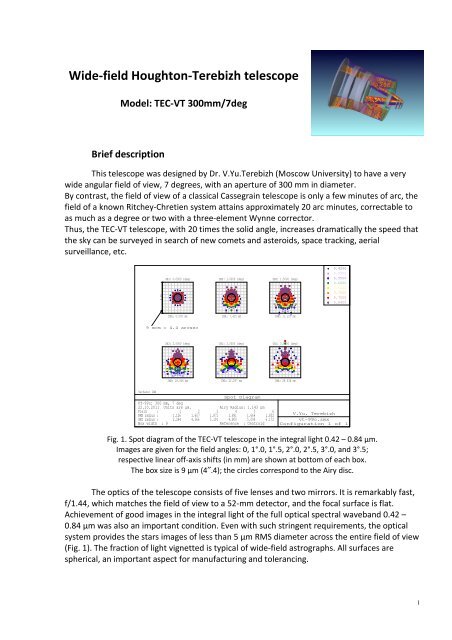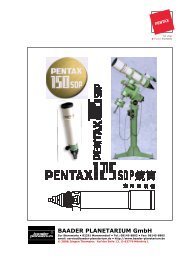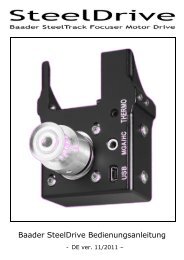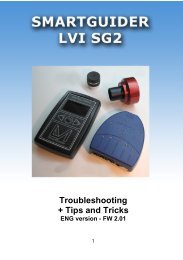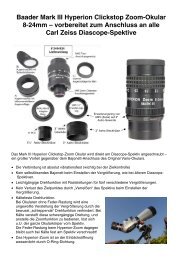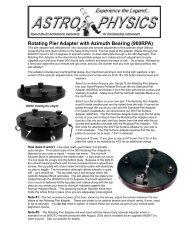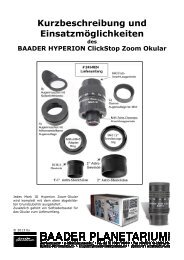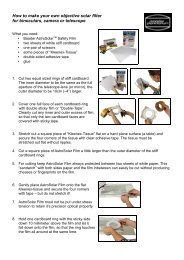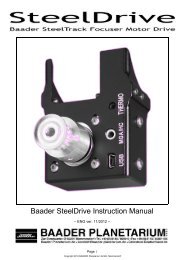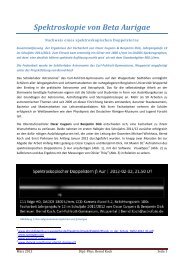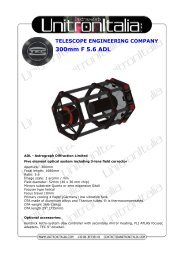Wide-field Houghton-Terebizh telescope - Baader Planetarium
Wide-field Houghton-Terebizh telescope - Baader Planetarium
Wide-field Houghton-Terebizh telescope - Baader Planetarium
Create successful ePaper yourself
Turn your PDF publications into a flip-book with our unique Google optimized e-Paper software.
<strong>Wide</strong>-<strong>field</strong> <strong>Houghton</strong>-<strong>Terebizh</strong> <strong>telescope</strong><br />
Model: TEC-VT 300mm/7deg<br />
Brief description<br />
This <strong>telescope</strong> was designed by Dr. V.Yu.<strong>Terebizh</strong> (Moscow University) to have a very<br />
wide angular <strong>field</strong> of view, 7 degrees, with an aperture of 300 mm in diameter.<br />
By contrast, the <strong>field</strong> of view of a classical Cassegrain <strong>telescope</strong> is only a few minutes of arc, the<br />
<strong>field</strong> of a known Ritchey-Chretien system attains approximately 20 arc minutes, correctable to<br />
as much as a degree or two with a three-element Wynne corrector.<br />
Thus, the TEC-VT <strong>telescope</strong>, with 20 times the solid angle, increases dramatically the speed that<br />
the sky can be surveyed in search of new comets and asteroids, space tracking, aerial<br />
surveillance, etc.<br />
9.00<br />
OBJ: 0.0000 (deg)<br />
IMA: 0.000 mm<br />
9 mcm = 4.4 arcsec<br />
OBJ: 2.5000 (deg)<br />
IMA: 18.566 mm<br />
OBJ: 1.0000 (deg)<br />
IMA: 7.415 mm<br />
OBJ: 3.0000 (deg)<br />
IMA: 22.297 mm<br />
Surface: IMA<br />
Spot Diagram<br />
VT-99c: 300 mm, 7 deg<br />
22.10.2011 Units are µm. Airy Radius: 1.143 µm<br />
Field : 1 2 3 4 5 6<br />
RMS radius : 1.126 1.607 1.871 1.891 1.664 1.852<br />
GEO radius : 2.244 4.366 5.191 4.800 5.099 6.172<br />
Box width : 9 Reference : Centroid<br />
OBJ: 1.5000 (deg)<br />
IMA: 11.127 mm<br />
OBJ: 3.5000 (deg)<br />
IMA: 26.038 mm<br />
0.4200<br />
0.5000<br />
0.5500<br />
0.6000<br />
0.6500<br />
0.7000<br />
0.7500<br />
0.8400<br />
V.Yu. <strong>Terebizh</strong><br />
vt-99c.zmx<br />
Configuration 1 of 1<br />
Fig. 1. Spot diagram of the TEC-VT <strong>telescope</strong> in the integral light 0.42 – 0.84 µm.<br />
Images are given for the <strong>field</strong> angles: 0, 1°.0, 1°.5, 2°.0, 2°.5, 3°.0, and 3°.5;<br />
respective linear off-axis shifts (in mm) are shown at bottom of each box.<br />
The box size is 9 µm (4″.4); the circles correspond to the Airy disc.<br />
The optics of the <strong>telescope</strong> consists of five lenses and two mirrors. It is remarkably fast,<br />
f/1.44, which matches the <strong>field</strong> of view to a 52-mm detector, and the focal surface is flat.<br />
Achievement of good images in the integral light of the full optical spectral waveband 0.42 –<br />
0.84 µm was also an important condition. Even with such stringent requirements, the optical<br />
system provides the stars images of less than 5 µm RMS diameter across the entire <strong>field</strong> of view<br />
(Fig. 1). The fraction of light vignetted is typical of wide-<strong>field</strong> astrographs. All surfaces are<br />
spherical, an important aspect for manufacturing and tolerancing.<br />
1
Optical design specifications<br />
Table 1<br />
Optical layout <strong>Houghton</strong>-<strong>Terebizh</strong><br />
Entrance pupil diameter 300 mm<br />
Effective focal length 425 mm<br />
Working focal ratio 1.44<br />
Scale in the focal plane 2.06 µm/arcsec<br />
Primary spectral waveband 0.42 – 0.84 µm<br />
Angular <strong>field</strong> of view 7°.0<br />
Field curvature Flat<br />
Linear diameter of the <strong>field</strong> 52.1 mm<br />
Fraction of unvignetted light<br />
Optical axis<br />
Edge of <strong>field</strong><br />
Linear obscuration coefficient<br />
Optical axis<br />
Edge of <strong>field</strong><br />
Effective aperture diameter<br />
Optical axis<br />
Edge of <strong>field</strong><br />
0.70<br />
0.57<br />
0.54<br />
0.65<br />
250 mm<br />
227 mm<br />
Back focal length (last lens surface – detector)<br />
RMS spot diameter (Drms) in the integral spectral range<br />
70 mm<br />
center – edge<br />
Diameter of circle that contains 80% of energy in a star image<br />
2.3 – 3.8 µm (1″.1 – 1″.8)<br />
(D80), integral light, center – edge<br />
5.5 – 7.1 µm (2″.7 – 3″.5)<br />
Distortion < 0.20%<br />
Harmful ghosts<br />
Axial length of the system<br />
Absent<br />
First – last surface<br />
373 mm<br />
First surface – detector<br />
443 mm<br />
The diameter of the flat <strong>field</strong> corresponds well to a diagonal of commonly available<br />
CCDs. In particular, a FLI PL16803 camera includes the TrueSense (formerly Kodak) KAF-16803<br />
chip with the 4096 × 4096 pixels of 9 μm size (36.9 × 36.9 mm; diagonal 52.1 mm). Another<br />
known detector, FLI PL09000, includes the KAF-09000 chip with the 3056 × 3056 pixels of 12 μm<br />
size (36.67 × 36.67 mm; diagonal 51.9 mm).<br />
The optical images are relatively less compared to the pixels of these detectors, and so<br />
the optics is not the limiting factor in attaining high signal-to-noise ratio for faint objects against<br />
the sky background.<br />
Optical tube assembly<br />
Table 2<br />
Weight, including FLI PL camera with CFW-9-5 filter wheel 41 kg<br />
Full length (baffle entrance – rear side of FLI) 1030 mm<br />
Mechanical design of the OTA features:<br />
A-thermal Titanium cells;<br />
Invar rods assembly for thermal stability of the focus;<br />
Orthogonal tip-tilt adjustment of the camera focal plane with micrometer<br />
adjustment (0.25 degree range);<br />
2
45 degree camera axial rotation;<br />
Belt-driven helical focusing mechanism with focusing range of 5 mm;<br />
Front baffle (410 mm OD × 550 mm long) is easily removable for transportation.<br />
Imaging equipment<br />
Fig.2. Optical tube assembly of the TEC-VT <strong>telescope</strong><br />
The following Finger Lakes Instrumentation components are very suitable matches<br />
for this <strong>telescope</strong>:<br />
ProLine camera of choice – PL16803 (any grade), or PL09000;<br />
Filter wheel – CFW-9-5 (5 positions for 65 mm square filters).<br />
Fig. 3. TEC-VT <strong>telescope</strong> at the North-East Astronomy Forum<br />
(NEAF, April 28 th -29 th , 2012)<br />
3
Relevant Information<br />
Optical design – Dr. Valery <strong>Terebizh</strong>,<br />
Sternberg Astronomical Institute, Moscow University, Russia<br />
valery@terebizh.ru http://terebizh.ru/V.YU.T<br />
OTA opto-mechanical design – Yuri Petrunin, TEC<br />
Optics – Alex Rychenko, TEC<br />
Mechanics – Sergei Zaretsky, TEC<br />
Publication:<br />
V.Yu.<strong>Terebizh</strong>, "New Designs of Survey Telescopes",<br />
Astronomical Notes/Astronomische Nachrichten, Vol. 332, No. 7, 714 – 742, 2011<br />
Telescope Engineering Company<br />
15730 W. 6-th Ave.,<br />
Golden, CO. 80401. USA<br />
www.<strong>telescope</strong>ngineering.com<br />
tec@idcomm.com<br />
303 273 9322<br />
4


